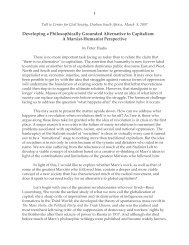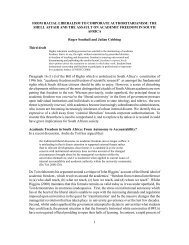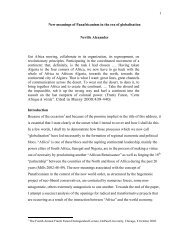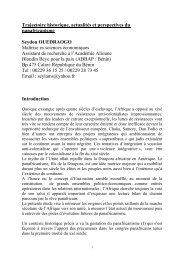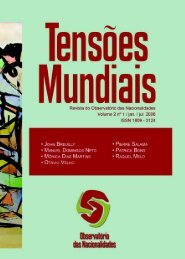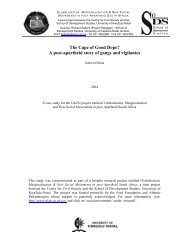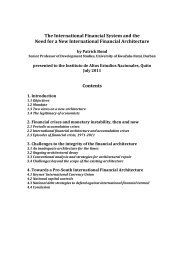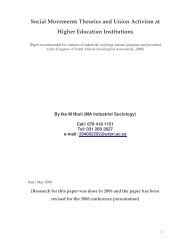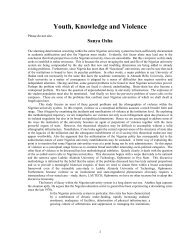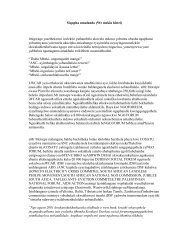April 2011 - Centre for Civil Society - University of KwaZulu-Natal
April 2011 - Centre for Civil Society - University of KwaZulu-Natal
April 2011 - Centre for Civil Society - University of KwaZulu-Natal
You also want an ePaper? Increase the reach of your titles
YUMPU automatically turns print PDFs into web optimized ePapers that Google loves.
century, Mandela and Lumumba representing the two ends <strong>of</strong> the pole that<br />
swung within the axis that marked the fulcrum <strong>of</strong> the struggle. The two<br />
men represent the beacon <strong>of</strong> light that shines sharply to bring absolute<br />
clarity into the evaluation <strong>of</strong> a history that is <strong>of</strong>ten mired in obfuscation<br />
and mendacity.<br />
To those who say, ‘How wonderful it was to see in Mandela, the issue <strong>of</strong><br />
oppression so peacefully resolved’, we need only point to that picture <strong>of</strong><br />
Patrice Lumumba, a torturer’s hand in his hair, as he was brutalised in a<br />
truck by black Kantangese soldiers at Elizabethville (now Kisangani).<br />
In that picture <strong>of</strong> Lumumba, serious students can espy unseen hands,<br />
steered by a ‘heart <strong>of</strong> darkness’, bribing, mixing poisons, assembling rifles<br />
with telescopic sights, and finally propping an elected prime minister<br />
against a tree in the bush and riddling his body with bullets.<br />
And then - could even Joseph Conrad, in his worst nightmarish ramblings,<br />
have imagined this? - first burying Lumumba’s body, then exhuming it a<br />
day later because the burial ground was too close to a road, and then<br />
hacking it to pieces, and shoving the pieces into a barrel filled with<br />
sulphuric acid, to dissolve it.<br />
And could Joseph Conrad have been able to picture the murderer making<br />
sure to break <strong>of</strong>f two front teeth from Lumumba’s jaw, to keep as a<br />
memento to show <strong>of</strong>f to the grand-children in Brussels in years to come? As<br />
well as one <strong>of</strong> the bullets that killed him? If Shakespeare could write black<br />
comedy, we might have got dialogue like this:<br />
‘Grandpa, what didst thou do in the Congo?’<br />
‘I exterminated Lumumba - and mark thee, that’s why I live in com<strong>for</strong>table<br />
retirement and, never ye <strong>for</strong>get this - that’s where<strong>for</strong>e ye went to such<br />
expensive schools. Here - see? Two <strong>of</strong> his very teeth that I broke <strong>of</strong>f and<br />
brought home! And this - the bullet that finished the job!’<br />
A Belgian, nearly 60 years after Conrad published his ‘Heart <strong>of</strong> Darkness’<br />
and 57 years after Roger Casement and E. D. Morel had made what they<br />
hoped was a definitive exposure <strong>of</strong> the crimes King Leopold The Second <strong>of</strong><br />
Belgium had committed against the Congolese people could still engage in<br />
such barbarities against a leader elected on the basis <strong>of</strong> a constitution<br />
signed into law by Leopold The Second’s own grandson, King Baudoin the<br />
first.<br />
That sordid crime in the bush near Elizabethville 50 years ago was the<br />
logical conclusion <strong>of</strong> a bitter and vigorous campaign that Belgium, aided by<br />
the United States, waged in the Congo in 1960 to ensure that Patrice<br />
Lumumba would never get a chance to rule the country that elected him<br />
to be its leader. Because <strong>of</strong> the action <strong>of</strong> Belgium and the United States,<br />
we actually do not know whether Lumumba would have made a good ruler<br />
or not. Which makes him even more important to history: <strong>for</strong> he was not<br />
assassinated merely as a person, but as an idea. What was that idea?<br />
It was the idea <strong>of</strong> a Congo that was fully independent, non-aligned, and<br />
committed to African unity. Lumumba’s party, the Mouvement National<br />
Congolais (MNC), was the only one in the Congo to organise itself<br />
successfully as a party that saw the Congo as one country, not as a<br />
conglomeration <strong>of</strong> ethnic groups. Thus, it gained 33 out <strong>of</strong> the 137 seats in<br />
the Congolese Parliament. From this relatively strong base, Lumumba was<br />
able to inspire others with his vision and thereby to hatch alliances that<br />
enabled the MNC to command an overall majority <strong>of</strong> seats in the Congolese



